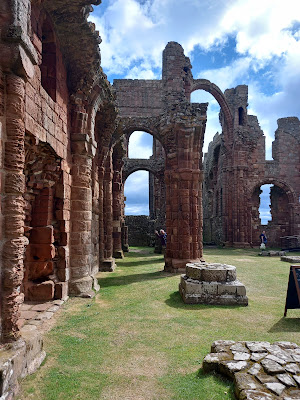Lindisfarne Holy Island is accessible by causeway only at low tide, so we had to make a prompt start to ensure that we weren’t trapped on the island. It’s a bit of a drive from Jarrow – we’d passed it on our way down from Edinburgh, but we made it there around ten-ish. We did the visitor information centre and Priory museum before heading into the ruins of the priory proper, so we knew exactly what we were looking at and who all the main people were. It's an English Heritage site, too, so yay! Savings! Some of them overlap with the historical personages we’ve met elsewhere on our travels around England. The original priory was where St Aidan first founded a monastery in 634, and used as the base for converting the north of England to Christianity, firstly by himself, then by St. Cuthbert who followed in his footsteps. They also wrote (or rather, copied) the Lindisfarne Gospels, written on calf vellum and illuminated, possibly by a team of monks. The main guy seems to have a chap called Eadfrith. The monastery lasted until the Dissolution of the Monasteries under Henry VIII, and the ruins now there date from that time.
After checking out the menus at two pubs, we settled on a
sandwich at a mobile kitchen. We took a brief tour of the gift shops and tasted
some meads, but nothing really took our interest sufficiently to part with any
cash. We then headed south to see Bamburgh Castle. This had been the stronghold
of the early kings of Northumbria. Later, during the War of the Roses, it
became the first castle to be defeated using that new-fangled weapon, gunpowder,
in the form of cannonfire.
As we approached the castle from the carpark, we were settled on by clouds of insects. Fortunately they don’t seem to be the biting kind, but they are annoying. Inside, we toured around the castle, including some of the state rooms that are open to the public, and we were able to take pictures indoors this time. The castle has been owned by the Armstrong family since the end of the 19th century, who have extensively restored it, and use it to live in for part of the year. The castle has also been used many times as a film set, including for the Netflix series The Last Kingdom.
 |
| Roomsful of trinkets |
 |
| It's very castle-y |
We had a cup of tea and a cake at the café, then made our way
back to Jarrow, again taking a route through the Tyne tunnel. We have one more
full day in the North East, then we head along Hadrian’s Wall (roughly) to
explore from the other side of the country.






No comments:
Post a Comment